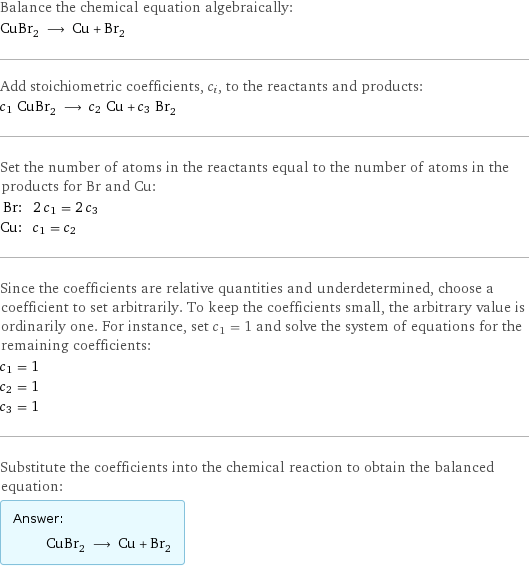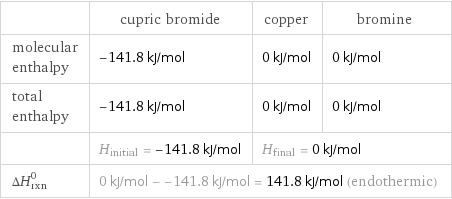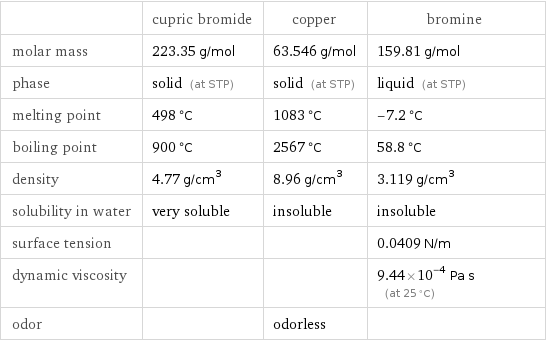Input interpretation

CuBr_2 cupric bromide ⟶ Cu copper + Br_2 bromine
Balanced equation

Balance the chemical equation algebraically: CuBr_2 ⟶ Cu + Br_2 Add stoichiometric coefficients, c_i, to the reactants and products: c_1 CuBr_2 ⟶ c_2 Cu + c_3 Br_2 Set the number of atoms in the reactants equal to the number of atoms in the products for Br and Cu: Br: | 2 c_1 = 2 c_3 Cu: | c_1 = c_2 Since the coefficients are relative quantities and underdetermined, choose a coefficient to set arbitrarily. To keep the coefficients small, the arbitrary value is ordinarily one. For instance, set c_1 = 1 and solve the system of equations for the remaining coefficients: c_1 = 1 c_2 = 1 c_3 = 1 Substitute the coefficients into the chemical reaction to obtain the balanced equation: Answer: | | CuBr_2 ⟶ Cu + Br_2
Structures

⟶ +
Names

cupric bromide ⟶ copper + bromine
Reaction thermodynamics
Enthalpy

| cupric bromide | copper | bromine molecular enthalpy | -141.8 kJ/mol | 0 kJ/mol | 0 kJ/mol total enthalpy | -141.8 kJ/mol | 0 kJ/mol | 0 kJ/mol | H_initial = -141.8 kJ/mol | H_final = 0 kJ/mol | ΔH_rxn^0 | 0 kJ/mol - -141.8 kJ/mol = 141.8 kJ/mol (endothermic) | |
Equilibrium constant
![Construct the equilibrium constant, K, expression for: CuBr_2 ⟶ Cu + Br_2 Plan: • Balance the chemical equation. • Determine the stoichiometric numbers. • Assemble the activity expression for each chemical species. • Use the activity expressions to build the equilibrium constant expression. Write the balanced chemical equation: CuBr_2 ⟶ Cu + Br_2 Assign stoichiometric numbers, ν_i, using the stoichiometric coefficients, c_i, from the balanced chemical equation in the following manner: ν_i = -c_i for reactants and ν_i = c_i for products: chemical species | c_i | ν_i CuBr_2 | 1 | -1 Cu | 1 | 1 Br_2 | 1 | 1 Assemble the activity expressions accounting for the state of matter and ν_i: chemical species | c_i | ν_i | activity expression CuBr_2 | 1 | -1 | ([CuBr2])^(-1) Cu | 1 | 1 | [Cu] Br_2 | 1 | 1 | [Br2] The equilibrium constant symbol in the concentration basis is: K_c Mulitply the activity expressions to arrive at the K_c expression: Answer: | | K_c = ([CuBr2])^(-1) [Cu] [Br2] = ([Cu] [Br2])/([CuBr2])](../image_source/175874b80db4aefa12469ec96abc1d5c.png)
Construct the equilibrium constant, K, expression for: CuBr_2 ⟶ Cu + Br_2 Plan: • Balance the chemical equation. • Determine the stoichiometric numbers. • Assemble the activity expression for each chemical species. • Use the activity expressions to build the equilibrium constant expression. Write the balanced chemical equation: CuBr_2 ⟶ Cu + Br_2 Assign stoichiometric numbers, ν_i, using the stoichiometric coefficients, c_i, from the balanced chemical equation in the following manner: ν_i = -c_i for reactants and ν_i = c_i for products: chemical species | c_i | ν_i CuBr_2 | 1 | -1 Cu | 1 | 1 Br_2 | 1 | 1 Assemble the activity expressions accounting for the state of matter and ν_i: chemical species | c_i | ν_i | activity expression CuBr_2 | 1 | -1 | ([CuBr2])^(-1) Cu | 1 | 1 | [Cu] Br_2 | 1 | 1 | [Br2] The equilibrium constant symbol in the concentration basis is: K_c Mulitply the activity expressions to arrive at the K_c expression: Answer: | | K_c = ([CuBr2])^(-1) [Cu] [Br2] = ([Cu] [Br2])/([CuBr2])
Rate of reaction
![Construct the rate of reaction expression for: CuBr_2 ⟶ Cu + Br_2 Plan: • Balance the chemical equation. • Determine the stoichiometric numbers. • Assemble the rate term for each chemical species. • Write the rate of reaction expression. Write the balanced chemical equation: CuBr_2 ⟶ Cu + Br_2 Assign stoichiometric numbers, ν_i, using the stoichiometric coefficients, c_i, from the balanced chemical equation in the following manner: ν_i = -c_i for reactants and ν_i = c_i for products: chemical species | c_i | ν_i CuBr_2 | 1 | -1 Cu | 1 | 1 Br_2 | 1 | 1 The rate term for each chemical species, B_i, is 1/ν_i(Δ[B_i])/(Δt) where [B_i] is the amount concentration and t is time: chemical species | c_i | ν_i | rate term CuBr_2 | 1 | -1 | -(Δ[CuBr2])/(Δt) Cu | 1 | 1 | (Δ[Cu])/(Δt) Br_2 | 1 | 1 | (Δ[Br2])/(Δt) (for infinitesimal rate of change, replace Δ with d) Set the rate terms equal to each other to arrive at the rate expression: Answer: | | rate = -(Δ[CuBr2])/(Δt) = (Δ[Cu])/(Δt) = (Δ[Br2])/(Δt) (assuming constant volume and no accumulation of intermediates or side products)](../image_source/cf2c97c6f840e965f1b32b96f056e4b8.png)
Construct the rate of reaction expression for: CuBr_2 ⟶ Cu + Br_2 Plan: • Balance the chemical equation. • Determine the stoichiometric numbers. • Assemble the rate term for each chemical species. • Write the rate of reaction expression. Write the balanced chemical equation: CuBr_2 ⟶ Cu + Br_2 Assign stoichiometric numbers, ν_i, using the stoichiometric coefficients, c_i, from the balanced chemical equation in the following manner: ν_i = -c_i for reactants and ν_i = c_i for products: chemical species | c_i | ν_i CuBr_2 | 1 | -1 Cu | 1 | 1 Br_2 | 1 | 1 The rate term for each chemical species, B_i, is 1/ν_i(Δ[B_i])/(Δt) where [B_i] is the amount concentration and t is time: chemical species | c_i | ν_i | rate term CuBr_2 | 1 | -1 | -(Δ[CuBr2])/(Δt) Cu | 1 | 1 | (Δ[Cu])/(Δt) Br_2 | 1 | 1 | (Δ[Br2])/(Δt) (for infinitesimal rate of change, replace Δ with d) Set the rate terms equal to each other to arrive at the rate expression: Answer: | | rate = -(Δ[CuBr2])/(Δt) = (Δ[Cu])/(Δt) = (Δ[Br2])/(Δt) (assuming constant volume and no accumulation of intermediates or side products)
Chemical names and formulas

| cupric bromide | copper | bromine formula | CuBr_2 | Cu | Br_2 Hill formula | Br_2Cu | Cu | Br_2 name | cupric bromide | copper | bromine IUPAC name | dibromocopper | copper | molecular bromine
Substance properties

| cupric bromide | copper | bromine molar mass | 223.35 g/mol | 63.546 g/mol | 159.81 g/mol phase | solid (at STP) | solid (at STP) | liquid (at STP) melting point | 498 °C | 1083 °C | -7.2 °C boiling point | 900 °C | 2567 °C | 58.8 °C density | 4.77 g/cm^3 | 8.96 g/cm^3 | 3.119 g/cm^3 solubility in water | very soluble | insoluble | insoluble surface tension | | | 0.0409 N/m dynamic viscosity | | | 9.44×10^-4 Pa s (at 25 °C) odor | | odorless |
Units
